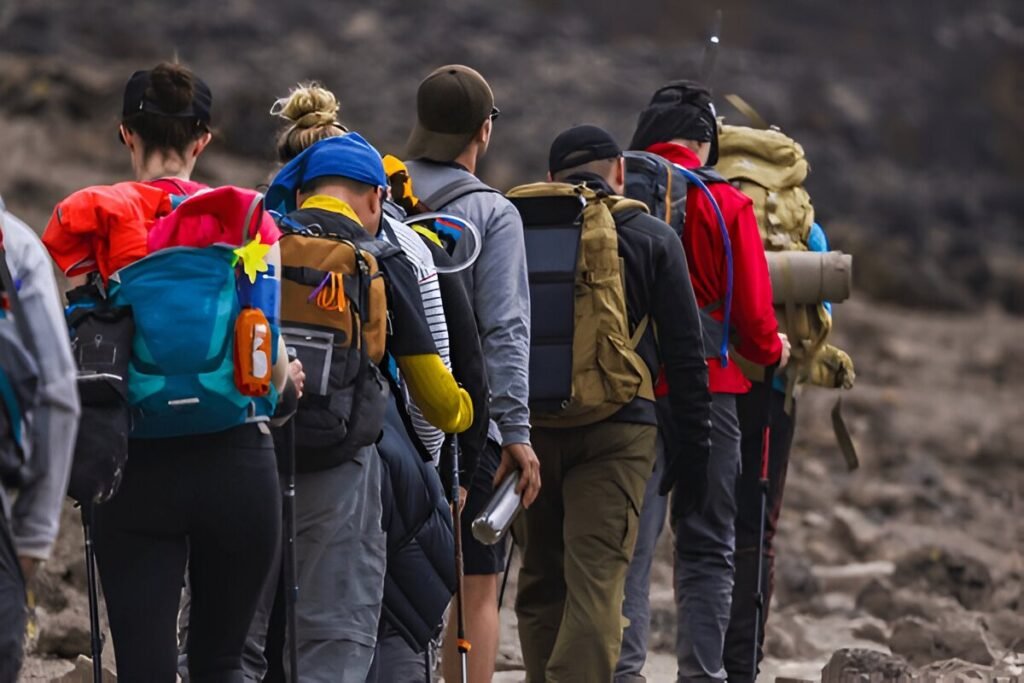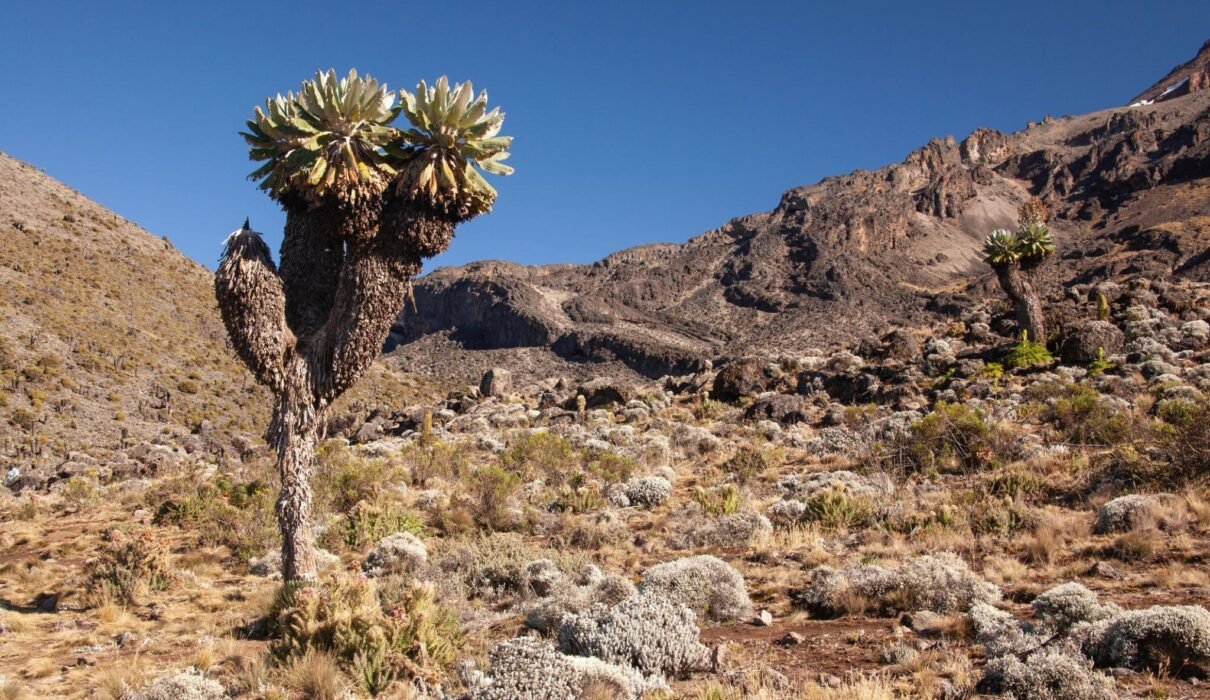8-Days Lemosho Route Kilimanjaro Climb 2025-2026 , Climbing Mount Kilimanjaro is a dream for many adventurers, and the Lemosho Route is one of the most scenic and rewarding paths to the summit. Known for its gradual ascent and stunning views, the 8-day Lemosho Route provides climbers with a better chance of acclimatizing, making it one of the best options for those looking for a more relaxed pace. If you’re planning a Kilimanjaro climb in 2024, 2025, or 2026, this guide will help you prepare for the ultimate adventure on Africa’s tallest mountain

8-Days Lemosho Route Kilimanjaro Climb 2025-2026 , Why Choose the Lemosho Route?
The Lemosho Route is considered one of the most beautiful and diverse routes on Kilimanjaro. It offers climbers the opportunity to experience a variety of ecosystems, from lush rainforests to alpine deserts and, ultimately, the icy summit of Uhuru Peak. The gradual ascent provides better acclimatization compared to shorter routes, increasing your chances of a successful summit.
8-Days Lemosho Route Kilimanjaro Climb 2025-2026 , Key Benefits of the Lemosho Route:
- Scenic views: Sweeping vistas and diverse landscapes.
- Better acclimatization: A gradual ascent gives your body time to adjust to the altitude.
- Fewer crowds: Less traffic compared to other routes, especially in the early stages of the trek.
Read more about why the Lemosho Route is a top choice for Kilimanjaro climbers.
8-Days Lemosho Route Kilimanjaro Climb 2025-2026 , 8-Day Lemosho Route Itinerary
Here’s a detailed overview of the 8-day Lemosho Route itinerary:
Day 1: Arrival in Moshi
Arrive in Moshi, where you’ll meet your guides and have a briefing about your climb. You’ll also check your gear to ensure you’re fully prepared for the trek.
Day 2: Lemosho Gate to Mti Mkubwa Camp (2,650m)
- Distance: 6 km
- Hiking time: 3-4 hours
- Habitat: Rainforest
Your journey starts at Lemosho Gate (2,100m), where you’ll begin hiking through the lush rainforest. Keep an eye out for colobus monkeys as you make your way to Mti Mkubwa Camp.
Discover more about the rainforest zone of Kilimanjaro.
Day 3: Mti Mkubwa Camp to Shira 1 Camp (3,500m)
- Distance: 8 km
- Hiking time: 5-6 hours
- Habitat: Moorland
Today, you’ll leave the rainforest and enter the moorland zone, where the landscape opens up to stunning views of the Shira Plateau. You’ll camp at Shira 1 Camp and enjoy your first views of Kilimanjaro’s summit in the distance.
Find out more about Kilimanjaro’s moorland ecosystem.
Day 4: Shira 1 Camp to Shira 2 Camp (3,850m)
- Distance: 7 km
- Hiking time: 4-5 hours
- Habitat: Moorland
A relatively short day of trekking, but the views across the Shira Plateau are spectacular. You’ll have time to rest and acclimatize at Shira 2 Camp, which offers panoramic views of Mount Meru in the distance.
Read more about the Shira Plateau.
Day 5: Shira 2 Camp to Barranco Camp via Lava Tower (4,600m)
- Distance: 10 km
- Hiking time: 7-8 hours
- Habitat: Alpine desert
This day is crucial for acclimatization as you climb to Lava Tower (4,600m) before descending to Barranco Camp (3,900m). The trek takes you through the alpine desert zone, where the landscape becomes more barren.
Learn about acclimatization and the importance of hiking to Lava Tower.
Day 6: Barranco Camp to Karanga Camp (4,050m)
- Distance: 5 km
- Hiking time: 4-5 hours
- Habitat: Alpine desert
The day begins with a climb up the famous Barranco Wall, a challenging but rewarding section of the trek. Once at the top, you’ll continue through the alpine desert to Karanga Camp, where you’ll spend the night.
Read more about climbing the Barranco Wall.
Day 7 of 8-Days Lemosho Route Kilimanjaro Climb 2025-2026: Karanga Camp to Barafu Camp (4,650m)
- Distance: 4 km
- Hiking time: 4-5 hours
- Habitat: Alpine desert
A relatively short hike brings you to Barafu Camp, the final camp before your summit push. You’ll have an early dinner and rest in preparation for the midnight ascent to the summit.
Learn more about Barafu Camp and the summit night.
Day 8 of 8-Days Lemosho Route Kilimanjaro Climb 2025-2026 : Summit Day – Barafu Camp to Uhuru Peak (5,895m), Descent to Mweka Camp (3,100m)
- Distance: 5 km ascent, 12 km descent
- Hiking time: 12-16 hours
- Habitat: Arctic
You’ll start your summit attempt around midnight, trekking through the night to reach Uhuru Peak at sunrise. After celebrating your achievement at the summit, you’ll begin the long descent to Mweka Camp for a well-earned rest.
Read more about summit night and what to expect at Uhuru Peak.
Day 9 of 8-Days Lemosho Route Kilimanjaro Climb 2025-2026 : Mweka Camp to Mweka Gate, Return to Moshi
- Distance: 10 km
- Hiking time: 3-4 hours
Your final day on Kilimanjaro takes you through the forested slopes back to Mweka Gate, where you’ll receive your summit certificate before returning to Moshi.
Discover more about the descent and final day of the trek.

8-Days Lemosho Route Kilimanjaro Climb 2025-2026 , Best Time to Climb Kilimanjaro (2025-2026)
Choosing the right time to climb Kilimanjaro is crucial for your success. The best times to climb are during the dry seasons:
- January to March: These months are less crowded, with cooler temperatures and a chance for snow at the summit.
- June to October: The most popular time to climb due to clear skies and warmer weather.
Avoid the rainy seasons (April-May and November) as trails can be slippery and conditions more challenging.
Learn more about the best times to climb Kilimanjaro.
8-Days Lemosho Route Kilimanjaro Climb 2025-2026 , Health and Vaccination Requirements
Before climbing Kilimanjaro, ensure you have the necessary vaccinations and health precautions in place. Key vaccinations to consider include:
- Yellow Fever: Required if traveling from a yellow fever-endemic country.
- Hepatitis A and B: Recommended for travel in Tanzania.
- Typhoid and Tetanus: Important for protection against food- and water-borne illnesses and injuries.
Additionally, consider taking malaria prevention medication for lower altitudes.
Read more about health tips and vaccinations for Kilimanjaro.
8-Days Lemosho Route Kilimanjaro Climb 2025-2026 , Training and Preparation for Kilimanjaro
While the Lemosho Route offers better acclimatization, physical fitness is essential for a successful climb. Training should focus on:
- Cardio training: Regular aerobic exercise, such as running or cycling.
- Strength training: Building leg and core strength.
- Hiking practice: Hiking with a loaded backpack to simulate the trek.
Find out more about how to prepare physically for Kilimanjaro.
8-Days Lemosho Route Kilimanjaro Climb 2025-2026 , Packing Essentials for the Lemosho Route
Packing the right gear is vital for comfort and safety on the mountain. Here are the essentials you’ll need:
Clothing:
- Base layers: Moisture-wicking tops and bottoms.
- Mid-layers: Fleece or insulated jacket.
- Outer layers: Waterproof and windproof jacket and pants.
- Footwear: Sturdy hiking boots with good ankle support.
Gear:
- Sleeping bag: Rated for sub-zero temperatures.
- Headlamp: Essential for the midnight summit ascent.
- Trekking poles: Helpful for both ascent and descent.
Check out a comprehensive Kilimanjaro packing list here.
8-Days Lemosho Route Kilimanjaro Climb 2025-2026 , Book Your Kilimanjaro Climb with Local Experts
Planning a successful Kilimanjaro climb involves choosing a trusted operator. Eddy Tours & Safaris provides expertly guided Kilimanjaro climbs via the Lemosho Route, with a focus on client safety and comfort. Their experienced guides ensure you’re well-prepared for the challenges ahead.
For those interested in combining a Tanzania safari with their climb, Kilimanjaro Climb Specialist offers custom packages that include both adventures, ensuring an unforgettable experience.
Start planning your Kilimanjaro climb with expert guidance.
Conclusion: Experience the Beauty of Kilimanjaro on the Lemosho Route
The 8-day Lemosho Route offers a scenic, less crowded, and rewarding way to summit Kilimanjaro. Whether you’re planning your climb for 2024, 2025, or 2026, this route provides excellent acclimatization and stunning landscapes. For a successful climb, trust Eddy Tours & Safaris or Kilimanjaro Climb Specialist to guide you every step of the way.
Inclusions
- Quality, waterproof, four-season mountain sleeping tents (on twin sharing basis)
- Emergency Oxygen Cylinder
- Quality Mess tents with table and chairs
- Conservation fees (part of park fees)
- All transfers to the mountain and back to your Moshi hotel
- Camping or Hut fees (part of park fees)
- Clean, purified drinking water
- Guides, Porters, Cook salaries and park fees
- Sleeping Mattress
- All meals while on the Mountain
- Rescue fees (part of park fees)
- Large portions of fresh, healthy, nutritious food
- Kilimanjaro summit certificate
- VAT (18% charged by the Government)
- Professional, experienced, mountain guides
Exclusions
Hotel (available as an optional addon)
Transfers (available as an optional addon)
Personal Expenses (e.g. laundry, telephone, beverages, etc.)
Surcharge for online payment of advance and balance (5% on each payment)
Tanzania Visa
Liquors, beers and bottled beverages
Personal trekking equipment such as sleepings bags, hiking boots, clothes, etc (available for renting)
Meals not listed in the itinerary
Travel insurance
International and domestic flights
Tips and gratuities

